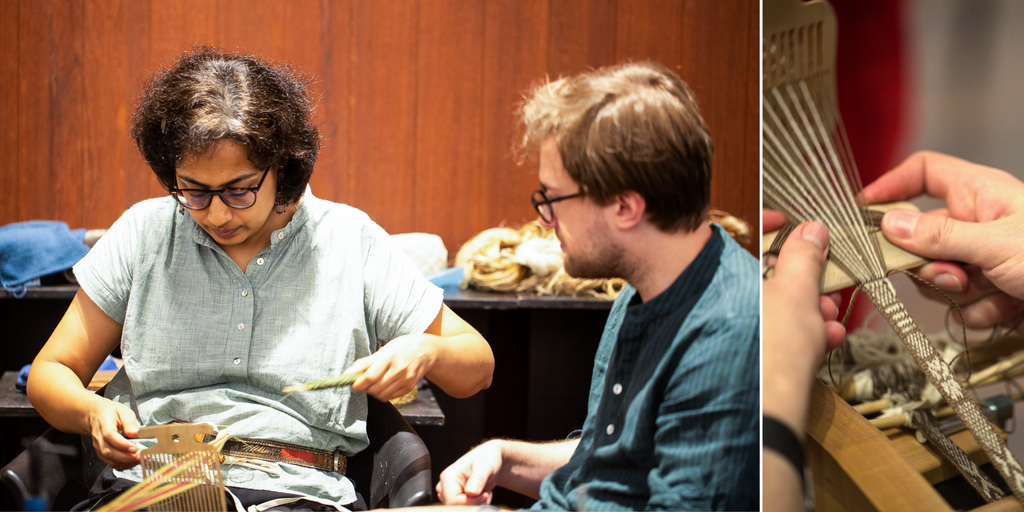Around the World: Backstrap and Heddle Loom Weaving

“Textiles are central to not only our daily lives but our cultural identity and human heritage.”
- Henry Skupniewicz
The most primitive weaving technique known is the backstrap loom. It receives its name from its primary constituent- a strap that is worn around the weaver’s waist. It can be set up almost anywhere, and is portable. Using the backstrap loom, a weaver can produce fabric with a ‘plain weave’. Most simply, this is an over-under-over-under pattern. Complex patterns can also be woven. ¹
Homo Sapiens had become Homo Faber (“man the maker”). In the early ages, sewing garments was a survival strategy. Despite the availability of machine development and fast-paced production, weaving using primitive tools is a practice that has stood the test of time. The loom continues to be used by indigenous people across the world. Certain indigenous tribes such as the Sentinelese of Brazil, the Dani’s of New Guinea and the Jarawas of India live within a self-sufficient economy.
One can claim that weaving is a ubiquitous practice. The same simple technology of using a warp and weft has resurged in various new forms, we see addition of elements like a frame or external support. There are several types of weaving looms with different features, but at their essence all of them perform this fundamental task.
Weaving is the exercise of interlacing a set of warp with a set of weft, creating a grid pattern of interlocking yarns. The warp is the “y” axis of the grid, or longitudinal yarns, which are kept under tension, and the weft is the “x” axis, or latitudinal yarns, which are passed over and under the warp. Looms can vary in complexity, using a frame, the weaver’s body, or even gravity to provide the necessary tension.
The heddle is an integral part of a loom. It segregates warp threads for the smooth passage of the weft, each individual thread within the warp traverses through a heddle.²
The role of the weaver’s back is key here; they use their lower body to actively regulate the tension on the warp threads. The width of the backstrap loom often depends on that of the weaver’s waist, which means that the size of the woven fabric is limited.

Source: Oklahoma’s Museum of Natural History
A = A cord or rope is used to tie the loom to a tree or post.
B = End bars are used to hold the warp (vertical threads) to the upper and lower ends of the loom.
C and D = Shed rods maintain the crossing of the warp’s threads.
E = The heddle rod lifts alternate threads of the warp.
F = The batten helps to separate alternate threads of the warp to allow the bobbin (G) to pass through them. The batten can also be used to tighten the weft (horizontal threads) as they are woven.
G = The bobbin, containing the thread of the weft, passes from side to side between the warp.
H = This belt is worn around the weaver’s back and connects her to the loom. The weaver controls the tension on the warp by leaning backward or forward.
Historical and archaeological evidence of the use of backstrap looms has been found across Peru, Guatemala, Bolivia, China, Tibet, Korea, Japan, Myanmar and India (specifically in Ladakh and the Northeast) where they are still in use today. In several communities in the north-eastern states of India like Nagaland, Mizoram, Manipur and Assam, weaving using a backstrap loom is a customary domestic practice for women that is passed down the generations. Indigenous tribes usually weave cloth that has a lot of meaning. Particularly, the women of northeast India take pride in their craft, since they weave clothes of prestige.

Ethnologists believe the use of the loom spread from South Asia to the Pacific Ocean, and eventually to South and Central America. In China, loom components fashioned out of bronze date back to the Bronze Age, whereas in Peru, representations of the backstrap loom on vessels of Mohican pottery have been dated to between 200 BCE and 1000 CE.
We are fortunate to live in a time where we can use these techniques for the love of making, as a recreational activity. The access to this craft is an opportunity to feed our innate desire to make and enable us to connect with the roots of human condition. Besides, engaging the mind and hands to practise a repetitive craft is proven as a meditative exercise.
Today when we look at these techniques of making, they not only outline communities of Indigenous identities; but also, highlight a global shared history that almost unifies us. In the context of the contemporary concern- loom weaving is emerging with the rise of the maker movement- a global recognition of the value of lost ancient crafts and economies. The handloom sector is aligned to the present global condition as it recognises value of crafts and skills of artisans.
- Harsimar Arora
Citations:
1 “Backstrap Weaving of Peru” Threads of Peru, threadsofperu.com/pages/backstrap-weaving-in-peru.
2 "Heddle." The Oxford English Dictionary. 2nd ed. 1989.
Learn Back-Strap Ridge Heddle Weaving with Henry Scupniewicz



Leave a comment